

In this tip:
- Introduction
- A)# Sowing dry seeds
- B)# Sowing germinated seeds
- C)# Sowing 1 or 2 seeds
- D)# Needed for sowing
- E)# Mixing small seeds with dry sand
About dropping or putting seeds in sowing holes in the soil.
.
Introduction
It is hard to sow (small) seeds on the garden soil; in a straight row and at fixed distances. Often there are too many seeds on 1 sowing spot or a few sowing spots are skipped (forgotten). When using the next “tools”, sowing is much easier.

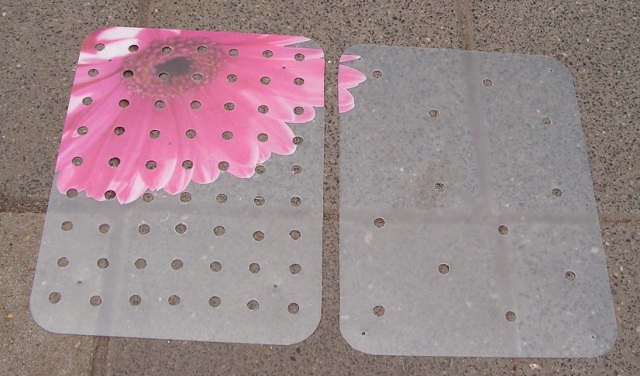

- A (piece of) sink mat, or a place mat with holes or a seed ruler with holes.

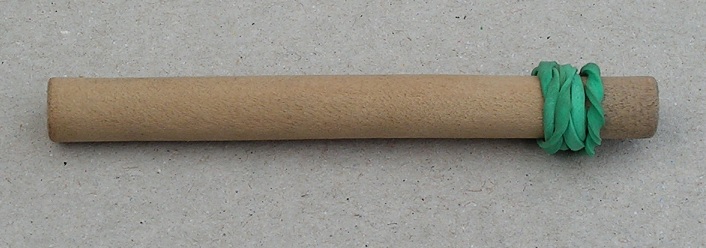
- A round sowing stick with elastic band around it.
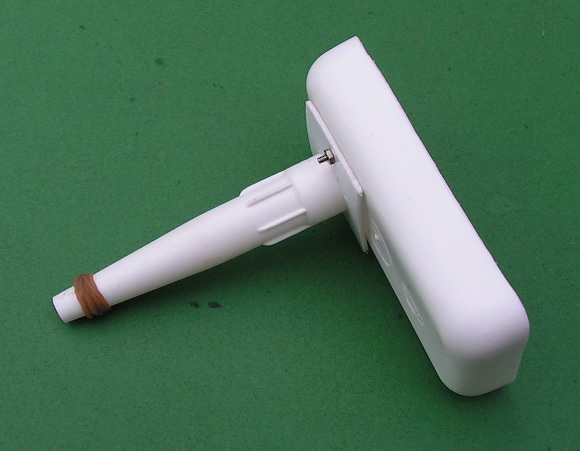
- A shift fall tray (shove drop tray) with 1 drop tube to sow dry seeds. See tip 33 how to make this tray.
.
Tip 34 describes how to sow seeds on a flat garden surface (using a shove drop tray and a mat or ruler): ● ● ●
During sowing or when removing the mat or the ruler, the seeds can roll away from the desired sowing spot: ● ● ●
When making sowing holes in the soil, you can sow the seeds in these holes: ‾‾‾| ●|‾‾‾‾|● |‾‾‾‾| ● |‾‾‾ The seeds don’t roll away. This way of sowing is described below.
.
You can sow “dry” seeds. Those are seeds that you shake out of the package. This sowing goes well when using a shove drop tray.
You can sow “pre-germinated” seeds. Those are seeds that have been germinated on moist (toilet) paper.
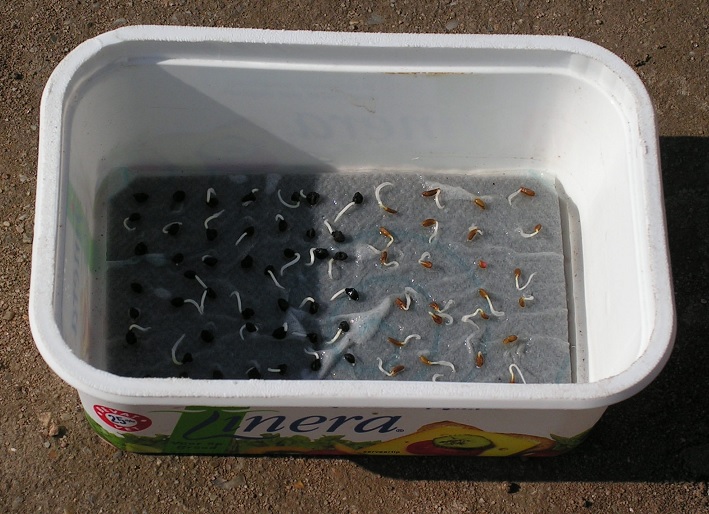
Pre-germinated leek seeds (left) or summer carrot seeds (right). Most seeds have a tiny root.
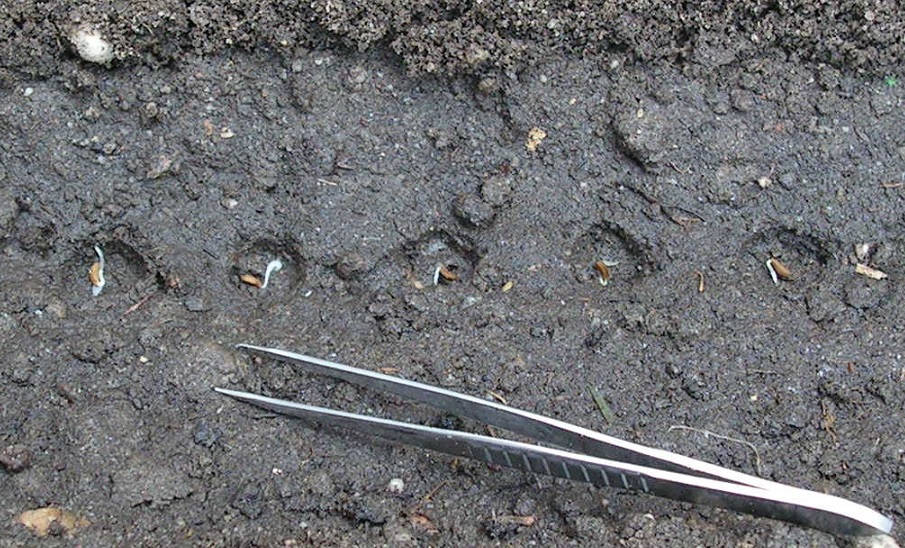
You can use tweezers to pick up pre-germinated seeds from the moist paper and to lay in sowing holes.
.
.
This tip describes sowing of dry or pre-germinated seeds. With many photos and little text.
.
A)# Sowing dry seeds (in a furrow or a sowing bed)


- Make a furrow or seed bed in loose garden soil.
- Spray water on the soil in the bed or furrow.
- Let water sink into the soil.

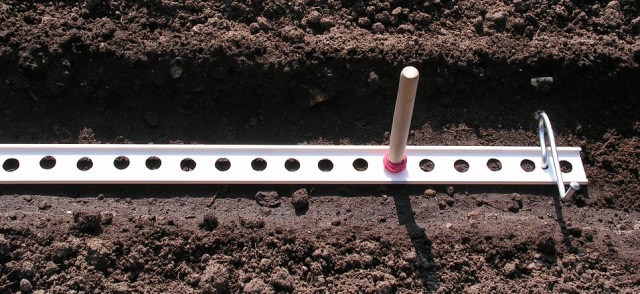



- Lay a piece of sink mat, seed ruler or place mat with holes on the soil.
- Use a sowing stick to make sowing holes in the garden soil;
- Use a stick with a sharp point to make \_/ shaped sowing holes.
- Use a stick with a straight point to make |_| shaped sowing holes.



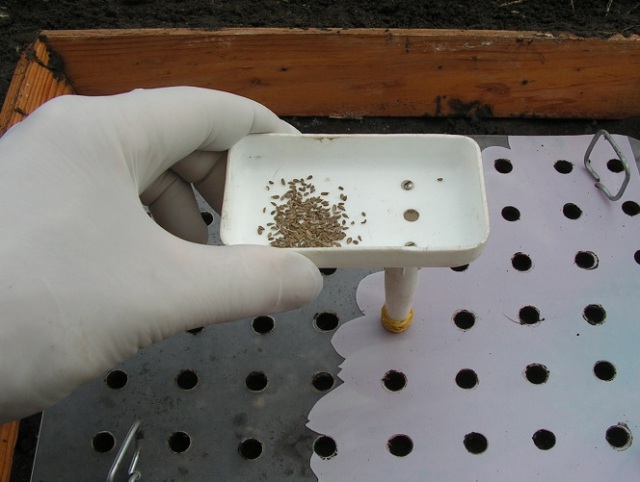
- Drop 1 (or a few seeds) in each sowing hole.
- Then remove the mat, seed ruler or place mat with holes.


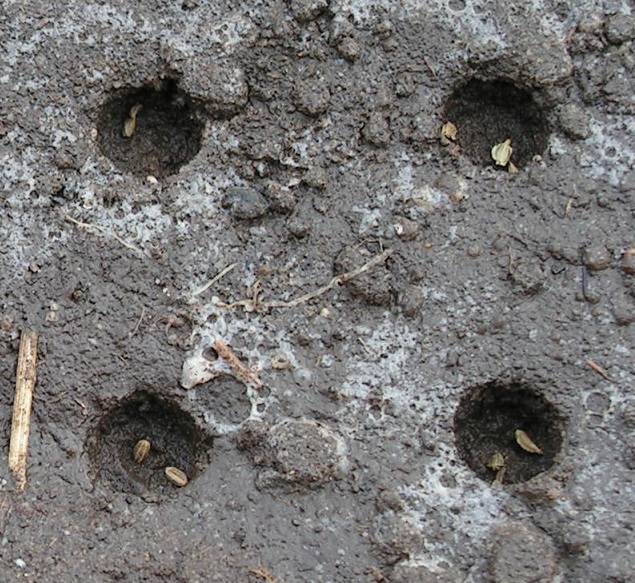
- In each sowing hole, there are one or a few carrot seeds or leek seeds.

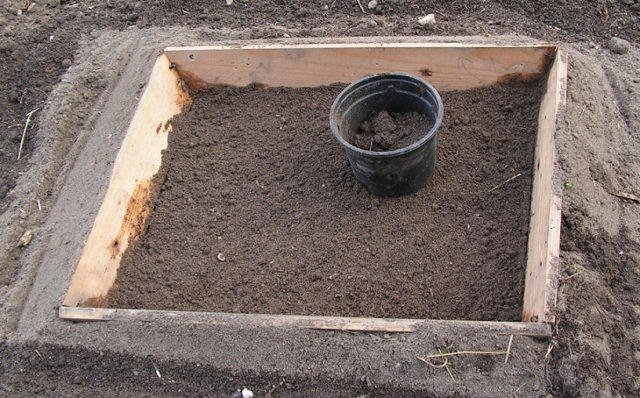
- Scatter (sprinkle) a thin layer of moist garden earth on the seeds.


- Cover the furrow or seed bed against drying out or flushing away during heavy rain.
- Remove the cover when small plants are there.
.
Remark: Shove drop tray with an extra tube around the drop tube.
You can put an extra piece of conduit pipe around the drop tube. Then you can sow without making sowing holes. The seeds don’t roll (far) away, but stay within the circle of the conduit pipe.
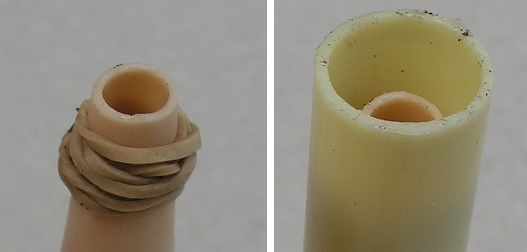
A piece of conduit pipe around the drop tube. The end of the conduit tube is about 0.5 centimeters (0.2 inch) “further” than the end of the drop tube.
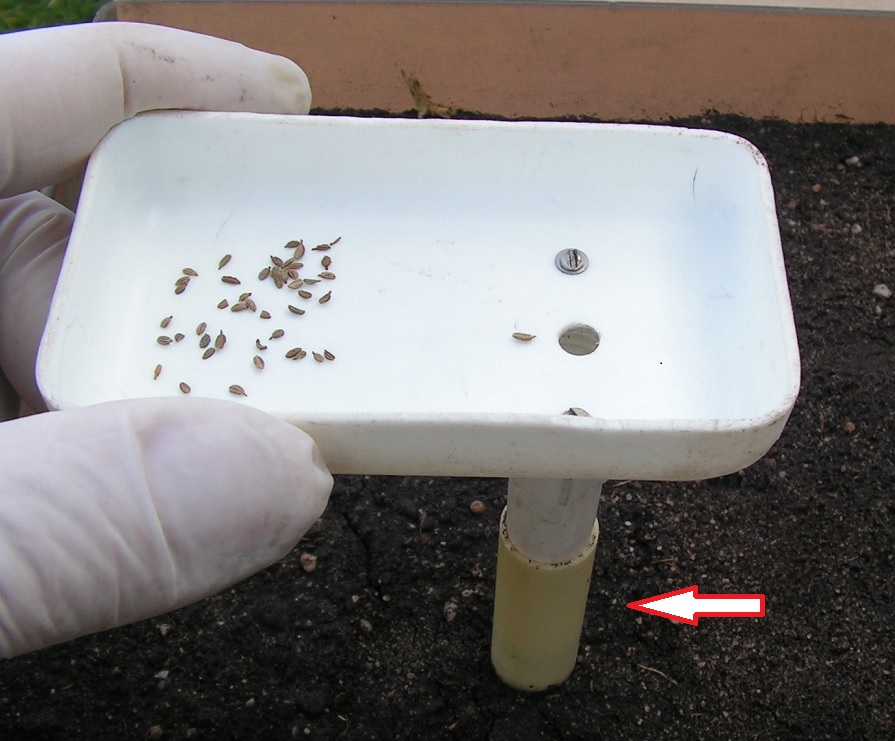
- Use the shove drop tray with extra conduit tube (red/white arrow) to sow;
- Put the shove drop tray on flat soil.
- Shove 1 or more seeds to the hole and drop the seed(s) on the soil.
- Move the tray to the next sowing spot and drop 1 or more seeds there.
- And so on.

- Carrot seeds, sown on flat garden soil, using this tray.
This method goes well too and and is much less work;
- No need for putting a mat, seed ruler or place mat on the soil.
- You don’t have to make sowing holes.
- At each sowing spot, there is a round print of the piece of conduit tube.
- At each sowing spot, the seed(s) is (are) within this print.
.
B)# Sowing pre-germinated seeds (in a furrow or a sowing bed)


- Make a furrow or seed bed in loose garden soil.
- Spray water on the soil in the bed or furrow.
- Let water sink into the soil.




- Lay a piece of sink mat, seed ruler or place mat with holes on the soil.
- Use a sowing stick to make sowing holes in the garden soil;
- Use a stick with a “straight point” to make |_| shaped sowing holes. This forms broad sowing holes.

- Remove the mat, seed ruler or place mat with holes.

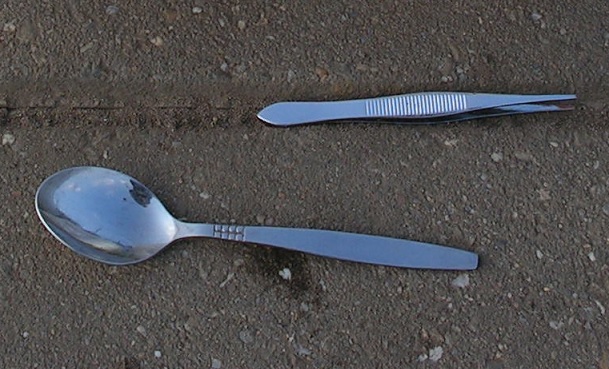
- Use tweezers when sowing pre-germinated seeds.
- Use tweezers to grab each seed from the paper and put it in a sowing hole.
- When needed, use water (in a tea spoon) to wash down a sticking seed from the tweezers.


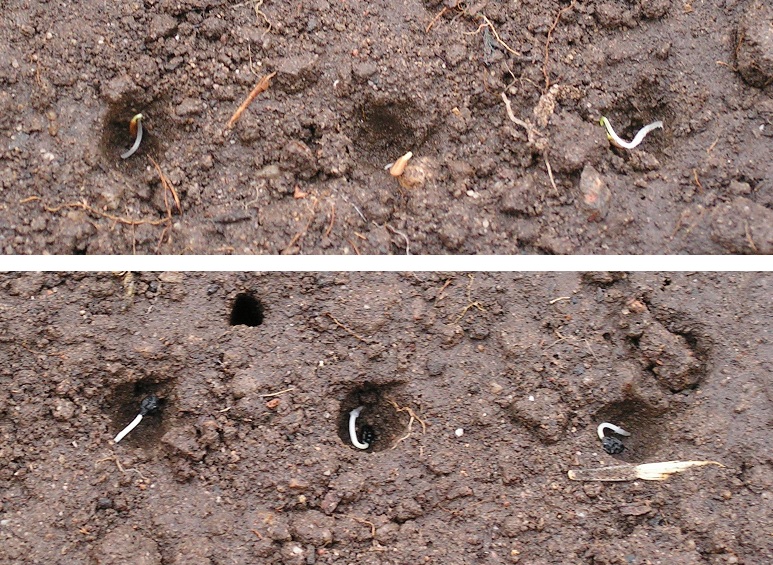
- In each sowing hole there is 1 pre-germinated carrot seed or leek seed.


- Scatter (sprinkle) moist garden soil on the seeds.


- Cover the furrow or seed bed against drying out or flushing away during heavy rain.
- Remove the cover when small plants are there.
.
C)# Sowing 1 or 2 seeds
When sowing summer carrots, it is good to drop 2 seeds per sowing spot. Then 1 or 2 carrot plants will grow at each sowing spot.
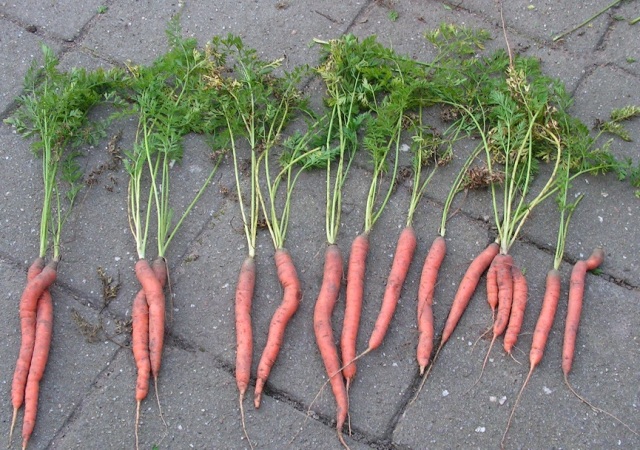
When 2 carrot plants grow at each spot, they can “hinder each other a little during growth”.
(I think that 3 carrot seeds per sowing spot is good too. I’m gonna try out).
.
D)# Needed for sowing
See tip 33 how to make or adapt the shove drop tray, the sowing stick and the sink mat.
The seed rules is described below.
.
D1) Shift fall tray (shove drop tray)

The shove drop tray with a thin drop tube. Near the outlet there is a rubber band. The rubber band prevents the tube from going too deep in a mat hole (or ruler hole or place mat hole). So there is no soil getting into the outlet of the drop tube. See tip 33 how to make this shove drop tray.
.
D2) Sowing stick

Use a stick with a “beveled point” to sow dry seeds. This makes the seeds “roll” to the middle of the sowing holes.
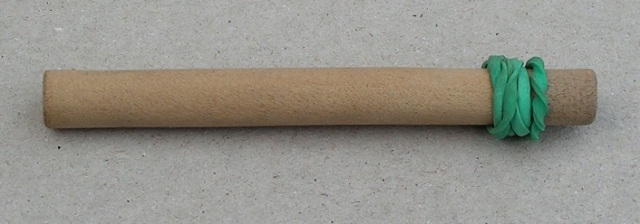
Use a stick with a straight end, so there is more space for a seed with a tiny root.
In tip 33) the making of the stick is described.
.
D3) Mat


The mat that I bought (top photo) has “closed areas”. You can make extra holes in the mat as shown on the bottom photo.
In tip 33) the adaptation of the mat is described.
.
D4) Sowing rule
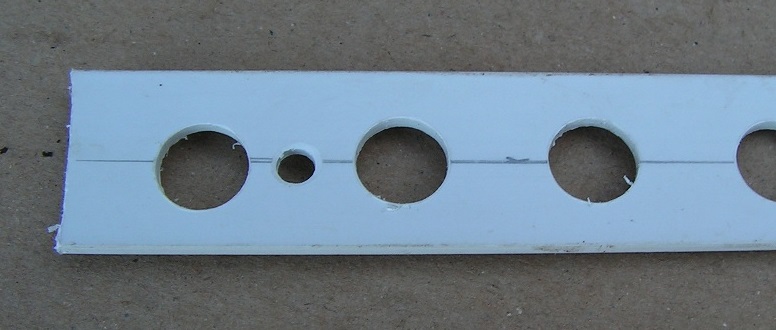
You can make a seed ruler.
Use a long white flat plastic strip, for sale in a DIY shop. Length 270 centimeters (9 ft) costs about € 4.00. Use a hack saw to shorten to about 70 centimeters (2 ft 4 inch).
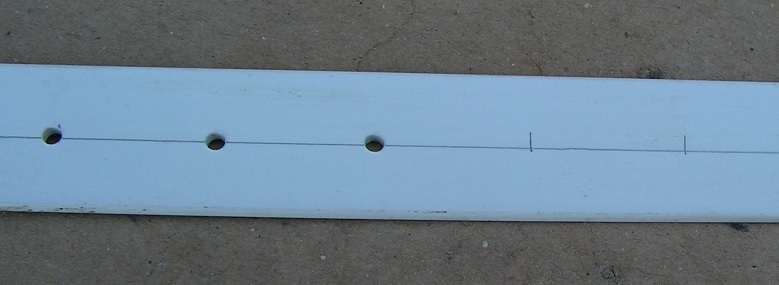
- Use a pencil to make a “mid line” on the strip.
- Use the pencil to put a “dash” on the mid line every ….. centimeters (pitch).
- At each “cross”, drill small holes in the strip (diameter 3 millimeters (1/8 inch)). Have a wooden plank under the strip during drilling.
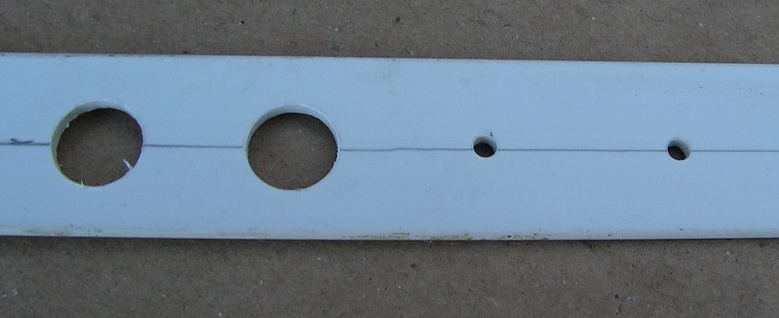
- Use a big drill (9.5 millimeter, 3 47/64 inch) to enlarge each small hole.
- Put the strip on a wooden plank.
- At each side of a small hole, lay a wooden lath on the strip. Push both wooden laths down during drilling
- Meanwhile (during pressing 2 laths on the strip) drill to enlarge the small hole to 9.5 millimeters).
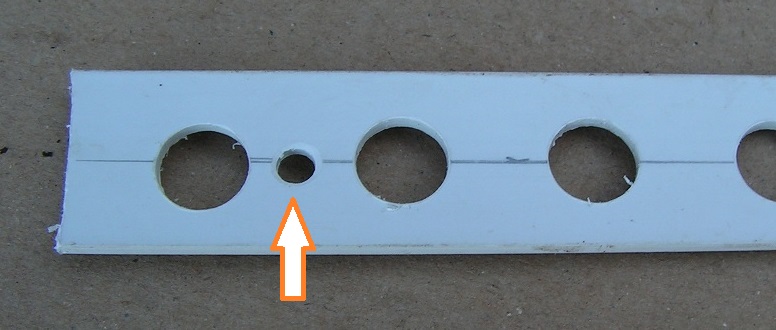
- Near each end of the strip, drill an extra hole (diameter 4 millimeters, 1/6 inch) between 2 big holes. This hole to put a locking pin in.
.
Or (an other strip purchased):
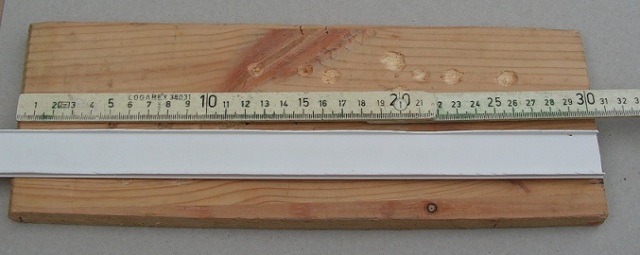

Use the lid of a “plastic cable tray” to make a seed ruler.
.
Remark: not for sale?
Maybe you can buy a piece of plastic perforated tape. Then you don’t have to drill holes in.
.
D5) Locking pins
You can make locking pens your self;


Use 2 pliers to bend pins from 1/10 inch (2.5 mm) iron wire. These pins press the ruler on the sowing soil.
.
E)# Mixing small seeds with dry sand
You can mix carrot seeds with dry sand. To improve the sowing. Some experiments below.
.
E1) Mixture of seeds and “not much” dry quartz sand, strewing from a plastic cup

- Use a plastic spoon to mix 14 dry carrot seeds with “a little volume” of dry quartz sand in a small plastic cup.
- Scatter the mixture from the cup on cardboard along a ruler.
- Do this 3 times in a row.

Carrot seeds on cardboard along a ruler. Three times scattered. Seeds are in clusters (groups).
.
E2) Mixture of seeds and “much” dry quartz sand, strewing from a plastic cup

- Use a plastic spoon to mix 14 dry carrot seeds with “a big volume” of dry quartz sand in a small plastic cup.
- Scatter the mixture from the cup on cardboard along a ruler.
- After scattering, use tweezers to shove each carrot seed in a straight line next to the dam of quartz sand.

Carrot seeds on cardboard along a ruler. Seeds are in clusters (groups).
.
E3) Mixture of seeds and “much” dry quartz sand, strewing from a small plastic V- shaped tray.

- At this test, mix 14 carrot seeds with a “big volume” of quartz sand in a plastic cup.
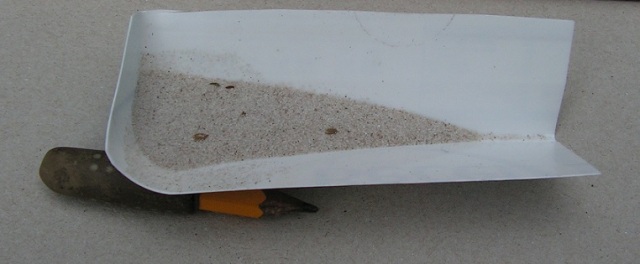
- Put the mixture from the cup into a plastic V-shaped tray (made from a margarine box).
- Scatter the mixture from the V-shaped tray on cardboard:
- Hold the tray a little slanting.
- Use tweezers or a pencil or pen to tap softly against the tray.
- Let the mixture drop from the tray on the cardboard.
- After scattering, use tweezers to shove each carrot seed in a straight line next to the dam of quartz sand.
- Do this test two times.
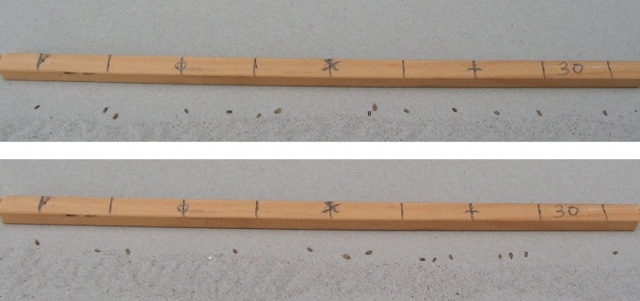
Carrot seeds on cardboard along a ruler. Seeds are evenly distributed.
.
E4) Conclusion
- Scattering a seed mixture from a round plastic cup on cardboard shows groups (clusters) with many or few seeds.
- When scattering from a V-shaped tray (and tapping against) the seeds are well (evenly) distrubuted.
It is difficult to keep dry carrot seeds well (evenly) mixed in dry quartz sand. When shaking this mixture, many “light weight” carrot seeds will show on top of the sand (due to the different density of quartz sand and seeds).
When scattering from a V-shaped tray, the seeds stay well mixed in the sand.

You sir are a treasure of excellent information! Thank you for your willingness to share your testing and ideas.
Hello Mark,
Thank you for the complement.
Greets, Sjef